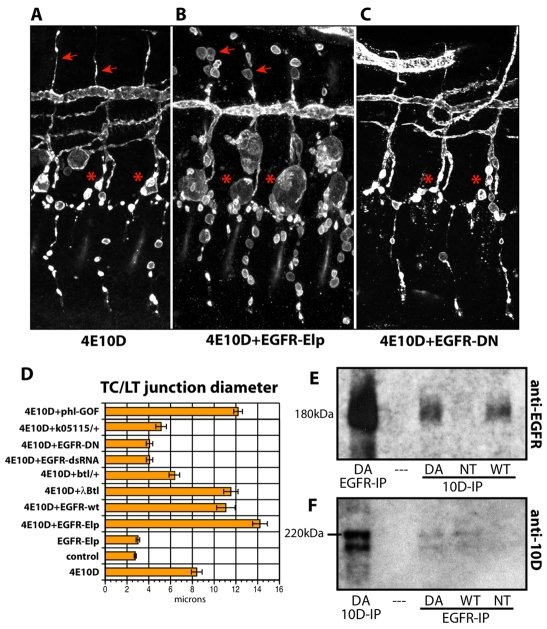Fig. 7.
Enhancement and suppression of the Ptp4E Ptp10D phenotype by Egfr constructs, and physical association between Ptp10D and Egfr. (A-C) Three hemisegments of stage 15 embryos stained for Sas are shown for (A) Ptp4E1 Ptp10D1, (B) Ptp4E1Ptp10D1; Btl-Gal4::UAS-EgfrElp, and (C) Ptp4E1Ptp10D1; Btl-Gal4::UAS-Egfr-DN. (B) Constitutively activated EgfrElp expression in the tracheae causes dramatic enlargement of TC/LT branch junction cysts (asterisks). Almost all GB cells have cysts, and DBs, which have few cysts in unmodified mutants (<1 cyst/embryo) have many cysts (arrows) in the modified mutants. (C) Expression of dominant-negative Egfr partially suppresses the Ptp4E1 Ptp10D1 cyst phenotype. GBs show fewer cysts and TC/LT branch junction cysts are smaller than in Ptp4E1 Ptp10D1. (D) Quantitation of the phenotypes. TC/LT branch junction diameters are increased relative to those of Ptp4E1 Ptp10D1 alone when EgfrElp, wt Egfr, activated Btl, or activated Raf (Phl) are expressed; they are decreased when Egfr signaling is reduced by using Egfr-DN or Egfr-RNAi, or by crossing in one copy of an Egfr or a btl mutation. Expression of EgfrElp in a wild-type background does not produce enlargement of the TC/LT branch junctions relative to wild-type controls. (E,F) Complex formation between Ptp10D and Egfr was detected by coimmunoprecipitation from lysates of copper-induced S2 cells stably expressing Egfr and transiently expressing wild-type or substrate-trapping mutant Ptp10D (both driven from the MT promoter). (E) Immunoblotting with anti-Egfr shows the 180 kDa Egfr band when anti-Egfr or anti-Ptp10D was used for immunoprecipitation from cells expressing wild-type or mutant (DA) Ptp10D. (F) Immunoblotting with anti-Ptp10D shows a doublet when anti-Ptp10D or anti-Egfr was used for immunoprecipitation from cells expressing wild-type or mutant (DA) Ptp10D. The upper band of the doublet is ∼220 kDa, corresponding to the expected size of a glycosylated version of full-length Ptp10D, which is 1931 amino acids in length; these bands are not present in lysates from Ptp10D mutants (see Fig. S4 in the supplementary material).

